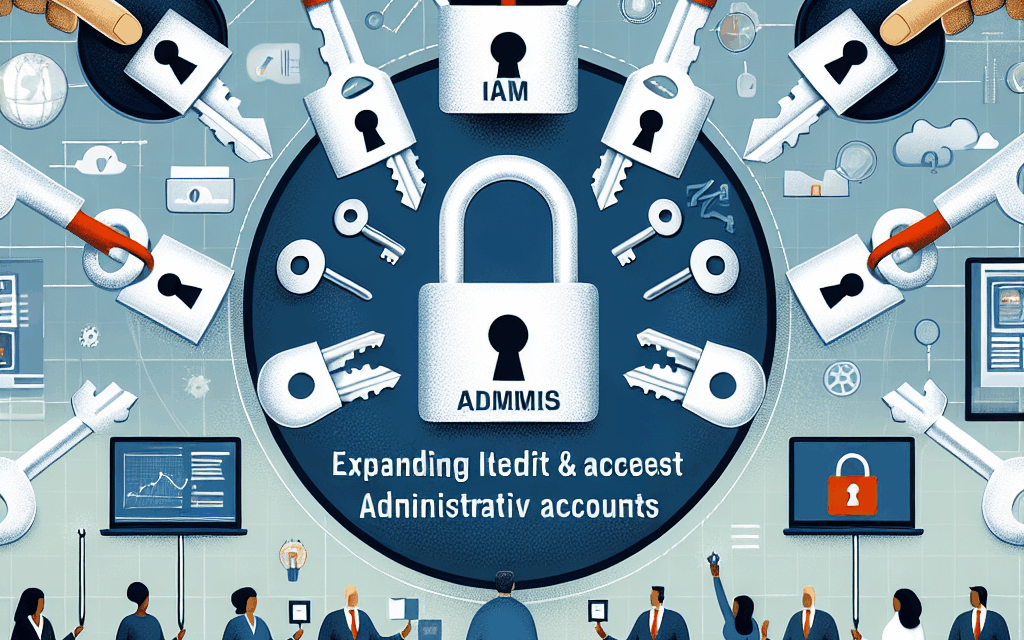Expanding IAM and Zero Trust Principles to All Admin Accounts
In the rapidly evolving landscape of cybersecurity, organizations are increasingly recognizing the importance of robust Identity and Access Management (IAM) systems and the Zero Trust security model. As cyber threats become more sophisticated, the need to secure administrative accounts—often the most targeted by attackers—has never been more critical. This article delves into the significance of expanding IAM and Zero Trust principles to all admin accounts, exploring the challenges, strategies, and best practices for implementation.
Understanding IAM and Zero Trust Principles
Before diving into the specifics of expanding IAM and Zero Trust principles, it is essential to understand what these concepts entail.
What is Identity and Access Management (IAM)?
Identity and Access Management (IAM) refers to the policies, technologies, and processes that ensure the right individuals have appropriate access to technology resources. IAM systems are designed to manage user identities and control access to sensitive information and systems. Key components of IAM include:
- User Provisioning: The process of creating, managing, and deleting user accounts and access rights.
- Authentication: Verifying the identity of users attempting to access systems.
- Authorization: Granting or denying access to resources based on user roles and permissions.
- Audit and Compliance: Monitoring and reporting on user access and activities to ensure compliance with regulations.
Effective IAM is crucial for protecting sensitive data and ensuring that only authorized users can access critical systems.
What is Zero Trust?
The Zero Trust security model operates on the principle of “never trust, always verify.” Unlike traditional security models that assume users inside the network are trustworthy, Zero Trust requires verification for every user and device, regardless of their location. Key principles of Zero Trust include:
- Least Privilege Access: Users are granted the minimum level of access necessary to perform their job functions.
- Micro-Segmentation: Networks are divided into smaller segments to limit lateral movement by attackers.
- Continuous Monitoring: Ongoing assessment of user behavior and access patterns to detect anomalies.
- Multi-Factor Authentication (MFA): Requiring multiple forms of verification before granting access.
By implementing Zero Trust principles, organizations can significantly reduce their attack surface and enhance their overall security posture.
The Importance of Securing Admin Accounts
Admin accounts are often the keys to an organization’s digital kingdom. They have elevated privileges that allow users to make significant changes to systems, access sensitive data, and manage other user accounts. As such, they are prime targets for cybercriminals. Here are several reasons why securing admin accounts is paramount:
1. High Value Targets for Cybercriminals
Admin accounts are highly coveted by attackers because they provide access to critical systems and sensitive data. A successful compromise of an admin account can lead to:
- Data breaches that expose sensitive customer information.
- Unauthorized changes to system configurations that can disrupt operations.
- Installation of malware or ransomware that can cripple an organization.
According to a report by Verizon, 81% of hacking-related breaches leverage stolen or weak passwords, highlighting the need for robust security measures around admin accounts.
2. Insider Threats
Not all threats come from external sources. Insider threats, whether malicious or accidental, can pose significant risks to organizations. Admin accounts, if misused by employees or contractors, can lead to:
- Data leaks that compromise sensitive information.
- Unintentional changes that disrupt services or lead to data loss.
- Deliberate sabotage or theft of intellectual property.
Implementing IAM and Zero Trust principles can help mitigate these risks by ensuring that admin accounts are monitored and controlled effectively.
3. Regulatory Compliance
Many industries are subject to strict regulatory requirements regarding data protection and access controls. Failing to secure admin accounts can lead to non-compliance, resulting in:
- Heavy fines and penalties from regulatory bodies.
- Reputational damage that can impact customer trust.
- Legal liabilities arising from data breaches.
By expanding IAM and Zero Trust principles to admin accounts, organizations can demonstrate their commitment to compliance and data protection.
4. Complexity of Modern IT Environments
As organizations adopt cloud services, remote work, and bring-your-own-device (BYOD) policies, the complexity of IT environments increases. This complexity can lead to:
- Increased attack surfaces that are difficult to monitor.
- Challenges in managing user access across multiple platforms.
- Difficulty in enforcing consistent security policies.
Expanding IAM and Zero Trust principles to all admin accounts can help organizations navigate these complexities by providing a unified approach to access management.
5. Evolving Threat Landscape
The threat landscape is constantly evolving, with new vulnerabilities and attack vectors emerging regularly. Cybercriminals are becoming more sophisticated, employing tactics such as:
- Phishing attacks to steal credentials.
- Exploiting software vulnerabilities to gain unauthorized access.
- Using social engineering techniques to manipulate users.
To stay ahead of these threats, organizations must adopt proactive security measures that include expanding IAM and Zero Trust principles to all admin accounts.
Strategies for Expanding IAM and Zero Trust Principles
Implementing IAM and Zero Trust principles across all admin accounts requires a strategic approach. Here are several key strategies organizations can adopt:
1. Implementing Least Privilege Access
One of the core tenets of Zero Trust is the principle of least privilege access. This means that users should only have access to the resources necessary for their job functions. To implement least privilege access for admin accounts, organizations should:
- Conduct a thorough review of existing admin accounts and their access levels.
- Establish role-based access controls (RBAC) to define permissions based on job roles.
- Regularly review and update access permissions to ensure they align with current job responsibilities.
By limiting access to only what is necessary, organizations can reduce the risk of unauthorized access and potential breaches.
2. Enforcing Multi-Factor Authentication (MFA)
MFA adds an additional layer of security by requiring users to provide multiple forms of verification before accessing admin accounts. This can include:
- Something the user knows (password).
- Something the user has (a mobile device or hardware token).
- Something the user is (biometric verification).
Implementing MFA for all admin accounts can significantly reduce the risk of unauthorized access, even if credentials are compromised. According to a study by Microsoft, MFA can block 99.9% of automated attacks.
3. Continuous Monitoring and Anomaly Detection
Continuous monitoring of admin account activities is essential for detecting potential security incidents. Organizations should implement:
- Real-time logging of admin account activities to track changes and access patterns.
- Anomaly detection systems that use machine learning to identify unusual behavior.
- Regular audits of admin account activities to ensure compliance with security policies.
By continuously monitoring admin accounts, organizations can quickly identify and respond to potential threats before they escalate.
4. Regular Security Training and Awareness
Human error is often a significant factor in security breaches. To mitigate this risk, organizations should invest in regular security training and awareness programs for all employees, particularly those with admin privileges. Training should cover:
- Best practices for password management and MFA usage.
- Recognizing phishing attempts and social engineering tactics.
- Understanding the importance of adhering to security policies and procedures.
By fostering a culture of security awareness, organizations can empower employees to take an active role in protecting sensitive information and systems.
5. Leveraging Advanced IAM Solutions
Organizations should consider leveraging advanced IAM solutions that incorporate Zero Trust principles. These solutions can provide features such as:
- Automated user provisioning and de-provisioning to streamline access management.
- Granular access controls that allow for fine-tuned permissions based on user roles.
- Integration with existing security tools for a comprehensive security posture.
By adopting advanced IAM solutions, organizations can enhance their ability to manage admin accounts securely and efficiently.
Case Studies: Successful Implementation of IAM and Zero Trust
To illustrate the effectiveness of expanding IAM and Zero Trust principles to admin accounts, let’s explore a few case studies of organizations that have successfully implemented these strategies.
Case Study 1: A Financial Institution
A large financial institution faced significant challenges in managing access to its sensitive data and systems. With numerous admin accounts across various departments, the organization was at risk of insider threats and external attacks. To address these challenges, the institution implemented the following measures:
- Conducted a comprehensive audit of all admin accounts to identify unnecessary privileges.
- Implemented role-based access controls to enforce least privilege access.
- Adopted MFA for all admin accounts, significantly reducing unauthorized access attempts.
- Established a continuous monitoring system to detect anomalies in admin account activities.
As a result of these measures, the financial institution reported a 75% reduction in security incidents related to admin accounts and improved compliance with regulatory requirements.
Case Study 2: A Healthcare Organization
A healthcare organization recognized the need to secure its admin accounts to protect sensitive patient data. The organization faced challenges with insider threats and compliance with HIPAA regulations. To enhance security, the organization took the following steps:
- Implemented a comprehensive IAM solution that included automated user provisioning and de-provisioning.
- Conducted regular security training for all employees, focusing on the importance of protecting admin accounts.
- Established a robust incident response plan to address potential security breaches involving admin accounts.
Following these initiatives, the healthcare organization achieved a significant improvement in its security posture, with zero reported breaches involving admin accounts over a two-year period.
Case Study 3: A Technology Company
A technology company with a global presence faced challenges in managing access to its cloud-based systems. With remote work becoming the norm, the organization needed to ensure that admin accounts were secure. The company implemented the following strategies:
- Adopted a Zero Trust approach, requiring verification for all users accessing admin accounts, regardless of location.
- Utilized advanced IAM solutions that integrated with existing security tools for enhanced visibility.
- Conducted regular audits of admin account activities to ensure compliance with security policies.
As a result, the technology company reported a 50% decrease in security incidents related to admin accounts and improved overall security awareness among employees.
Challenges in Implementing IAM and Zero Trust Principles
While expanding IAM and Zero Trust principles to all admin accounts offers significant benefits, organizations may encounter several challenges during implementation. Understanding these challenges can help organizations develop effective strategies to overcome them.
1. Resistance to Change
Implementing new security measures often meets resistance from employees who may be accustomed to existing processes. To address this challenge, organizations should:
- Communicate the importance of security measures and their impact on protecting sensitive information.
- Involve employees in the decision-making process to foster a sense of ownership.
- Provide training and support to help employees adapt to new processes.
2. Complexity of Existing Systems
Many organizations have complex IT environments with legacy systems that may not easily integrate with modern IAM solutions. To navigate this challenge, organizations should:
- Conduct a thorough assessment of existing systems to identify integration points.
- Consider phased implementation to gradually transition to new solutions.
- Engage with vendors who offer solutions compatible with legacy systems.
3. Resource Constraints
Implementing IAM and Zero Trust principles may require significant resources, including time, budget, and personnel. To address resource constraints, organizations should:
- Prioritize initiatives based on risk assessments and organizational needs.
- Explore partnerships with third-party vendors to leverage their expertise and resources.
- Invest in training existing staff to build internal capabilities.
4. Keeping Up with Evolving Threats
The cybersecurity landscape is constantly changing, making it challenging for organizations to stay ahead of emerging threats. To mitigate this challenge, organizations should:
- Establish a dedicated security team responsible for monitoring threats and vulnerabilities.
- Participate in industry forums and information-sharing initiatives to stay informed about emerging threats.
- Regularly update security policies and procedures to reflect the evolving threat landscape.
5. Balancing Security and Usability
While security is paramount, organizations must also consider the impact of security measures on user experience. To strike a balance between security and usability, organizations should:
- Implement user-friendly authentication methods, such as biometrics or single sign-on (SSO).
- Regularly gather feedback from users to identify pain points and areas for improvement.
- Continuously evaluate security measures to ensure they do not hinder productivity.
Conclusion
Expanding IAM and Zero Trust principles to all admin accounts is essential for organizations seeking to enhance their cybersecurity posture. By understanding the importance of securing admin accounts, implementing effective strategies, and overcoming challenges, organizations can significantly reduce their risk of cyber threats. The case studies presented demonstrate that organizations can achieve substantial improvements in security by adopting these principles.
As the threat landscape continues to evolve, organizations must remain vigilant and proactive in their approach to cybersecurity. By prioritizing IAM and Zero Trust principles, organizations can protect their most valuable assets—sensitive data and systems—while fostering a culture of security awareness among employees. The journey toward a more secure environment may be challenging, but the rewards are well worth the effort.





